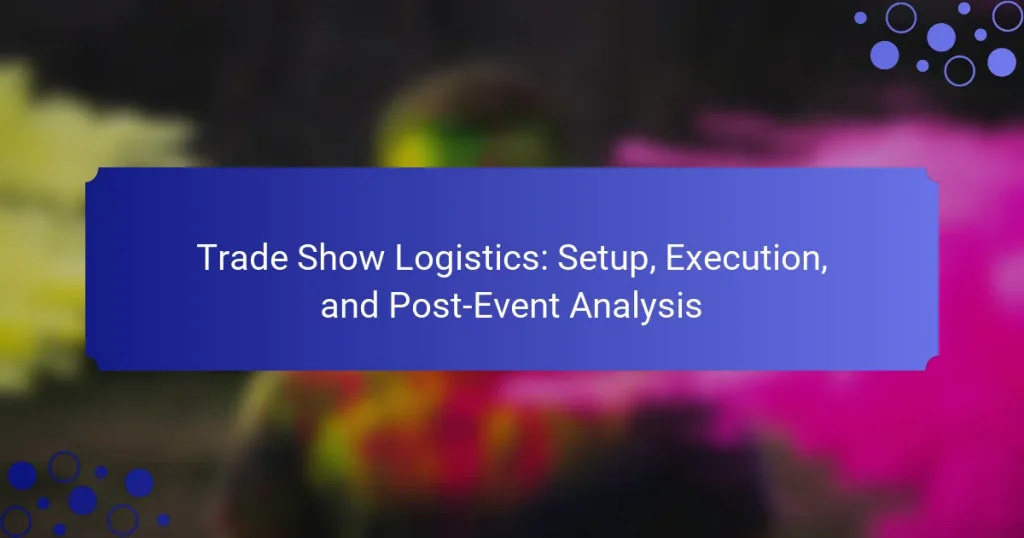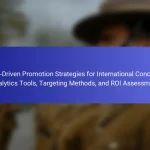Trade show logistics encompass the planning and management of essential elements for successful trade show participation, including transportation, booth setup, and material handling. Effective logistics are crucial, as they ensure timely arrival and proper setup of exhibits, while also facilitating coordination among vendors, venue management, and exhibitors. Key strategies for optimizing trade show logistics include meticulous planning, clear communication, and the use of technology to enhance execution. Additionally, post-event analysis plays a vital role in assessing attendance, visitor engagement, and logistical performance to inform future trade show strategies. This article outlines the comprehensive process of trade show logistics, from setup to execution and post-event evaluation.
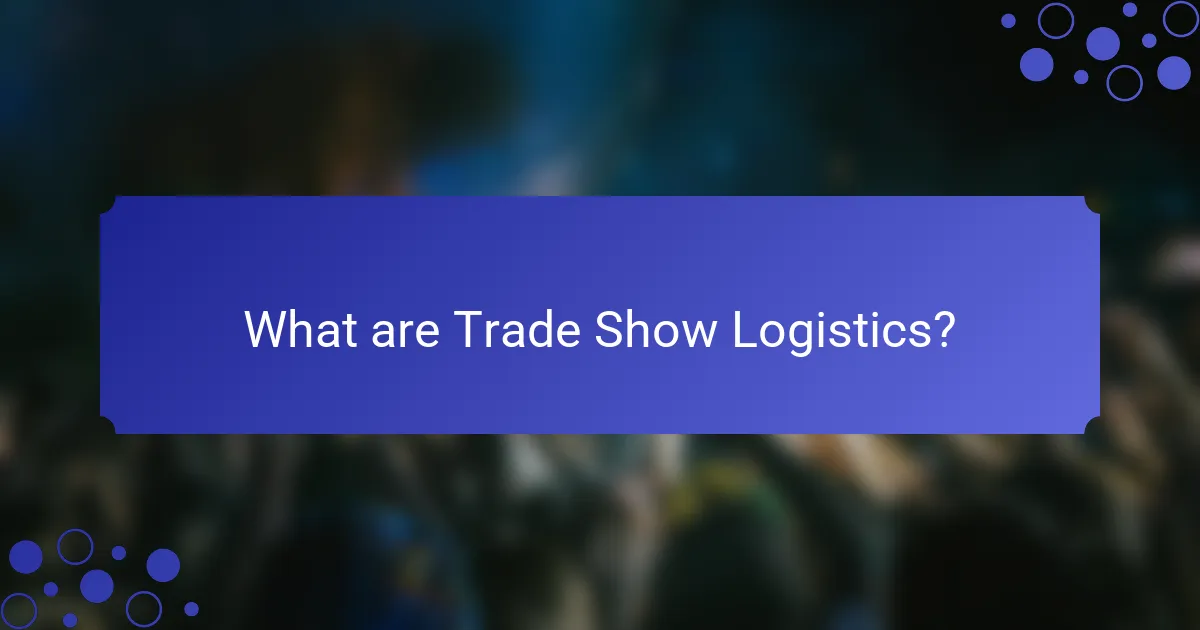
What are Trade Show Logistics?
Trade show logistics refer to the planning and management of the various elements involved in trade show participation. This includes transportation, booth setup, and material handling. Effective logistics ensure that exhibits arrive on time and are set up correctly. It also encompasses coordination between vendors, venue management, and exhibitors. Proper logistics can significantly impact the success of a trade show. According to the Trade Show Exhibitors Association, 70% of exhibitors cite logistics as a critical factor in their overall event experience.
How do Trade Show Logistics impact event success?
Trade show logistics significantly impact event success by ensuring smooth operations and maximizing attendee experience. Effective logistics streamline setup and teardown processes, reducing downtime. Proper planning facilitates timely delivery of materials and equipment, which is crucial for maintaining schedules. Coordination of transportation and storage minimizes costs and prevents last-minute issues. Efficient crowd management enhances visitor engagement and satisfaction. According to the Event Marketing Institute, 78% of attendees cite organization as a key factor in their overall experience. Therefore, well-executed logistics directly correlate with higher attendance and positive feedback, ultimately influencing the event’s success.
What are the key components of Trade Show Logistics?
The key components of trade show logistics include planning, transportation, setup, and management. Planning involves defining objectives and creating timelines. Transportation ensures that all materials arrive on time and in good condition. Setup includes arranging the booth and ensuring all equipment is functional. Management oversees the operation during the event, coordinating staff and handling issues. Each component is critical for a successful trade show. Efficient logistics can improve attendee experience and maximize brand visibility.
Why is planning essential in Trade Show Logistics?
Planning is essential in trade show logistics to ensure a smooth execution of the event. It helps in coordinating various aspects such as transportation, booth design, and staffing. Effective planning minimizes the risk of delays and errors. According to the Event Marketing Institute, 80% of event success is attributed to thorough planning. A well-structured plan allows for better resource allocation. It also enables tracking of timelines and budgets. Additionally, planning facilitates communication among team members. This results in a cohesive effort towards achieving event goals.
What are the phases of Trade Show Logistics?
The phases of trade show logistics include planning, execution, and post-event analysis. Planning involves selecting the venue, organizing transportation, and coordinating booth design. Execution focuses on setting up the booth, managing on-site staff, and ensuring all materials are delivered on time. Post-event analysis includes evaluating performance, gathering feedback, and analyzing leads generated. Each phase is critical for successful trade show participation and contributes to overall event effectiveness.
What happens during the setup phase of Trade Show Logistics?
During the setup phase of Trade Show Logistics, exhibitors prepare their booths and displays. This involves assembling structures, setting up lighting, and arranging products. Logistics teams coordinate the delivery of materials to the venue. They ensure that all equipment is in working order. Additionally, they verify that all necessary permits and regulations are met. The setup phase typically occurs one to two days before the event. Effective communication among team members is crucial during this time. This preparation directly impacts the overall success of the trade show.
How is the execution phase managed in Trade Show Logistics?
The execution phase in trade show logistics is managed through detailed planning and coordination. Key activities include the setup of exhibits, transportation of materials, and on-site management. Effective communication among team members ensures tasks are completed on schedule. Resource allocation is critical to prevent delays. Monitoring progress helps identify and resolve issues quickly. Adhering to timelines is essential for a successful execution. Coordination with venue staff facilitates a smooth operation. These practices lead to efficient trade show logistics execution.
What is involved in the post-event analysis of Trade Show Logistics?
Post-event analysis of trade show logistics involves evaluating the effectiveness of the logistics processes used during the event. This includes assessing the planning, execution, and outcomes of logistics strategies. Key components include gathering data on attendee engagement and feedback. Analyzing the efficiency of transportation and setup is also crucial. Reviewing vendor performance and coordination helps identify strengths and weaknesses. Financial analysis of logistics costs versus budgeted amounts is essential. Finally, compiling insights into a report aids future planning and improvements.
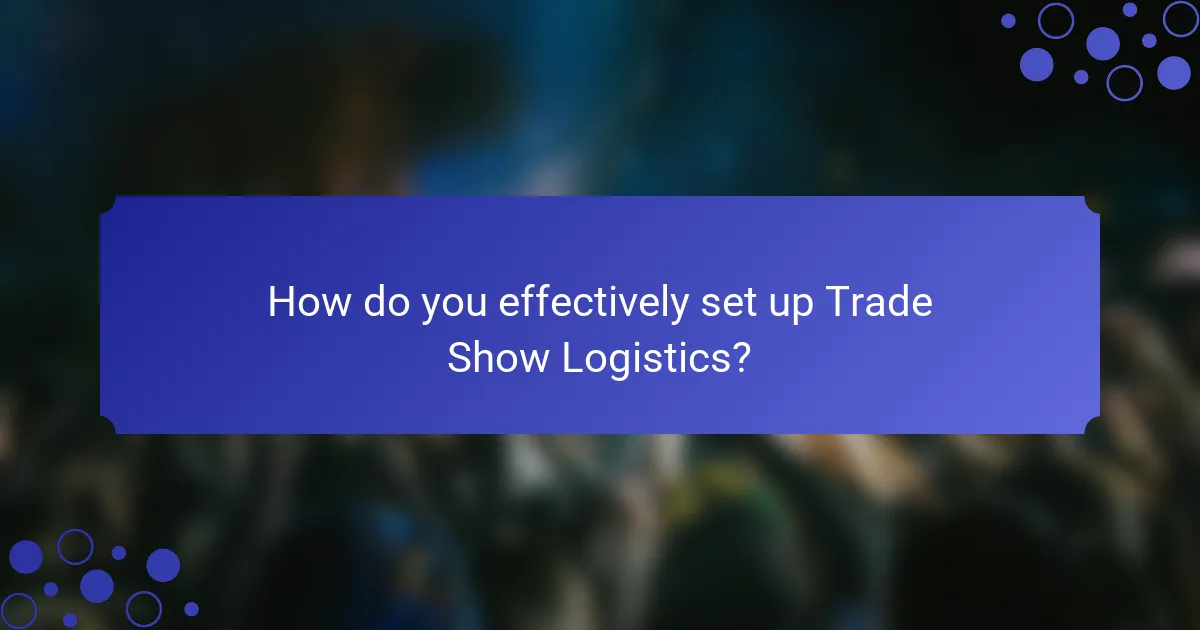
How do you effectively set up Trade Show Logistics?
To effectively set up trade show logistics, start by defining clear objectives for the event. Identify your target audience and desired outcomes. Next, create a detailed timeline that includes all logistical tasks. This timeline should cover deadlines for booth design, shipping, and setup. Secure necessary permits and comply with venue regulations to avoid issues. Coordinate with vendors for equipment rental, catering, and audiovisual needs. Develop a transportation plan for materials to ensure timely delivery. Assign roles to team members for seamless execution during the event. Finally, conduct a pre-show checklist to verify all logistics are in place. These steps ensure a well-organized trade show presence, enhancing overall effectiveness.
What are the best practices for setup in Trade Show Logistics?
The best practices for setup in Trade Show Logistics include detailed planning and effective communication. Start by confirming the layout and design of the booth well in advance. This ensures that all materials fit and are positioned correctly. Utilize a checklist to track all items needed for setup. This reduces the risk of forgetting essential components. Schedule setup times strategically to avoid congestion. This allows for a smoother installation process. Engage with venue staff for assistance with logistics and compliance. Their expertise can help navigate venue-specific regulations. Conduct a final walkthrough before the event starts. This ensures everything is in place and functioning properly. Following these practices enhances efficiency and effectiveness during trade show logistics.
How do you choose the right venue for a trade show?
To choose the right venue for a trade show, assess location, capacity, and amenities. The venue should be easily accessible for attendees. Consider proximity to hotels and transportation. Ensure the venue can accommodate the expected number of exhibitors and visitors. Evaluate the available facilities, such as Wi-Fi, parking, and catering options. Review the layout for optimal flow and visibility of exhibits. Check for any additional services offered by the venue, like technical support. Compare costs and contracts to ensure budget alignment. A well-chosen venue enhances attendee experience and event success.
What equipment and materials are necessary for setup?
Necessary equipment and materials for setup include display booths, signage, and promotional materials. Additionally, lighting, furniture, and electrical supplies are essential. Tools for assembly, such as screwdrivers and wrenches, are also required. Other items include flooring, cables, and storage solutions. Each component ensures an effective and professional presentation at a trade show. Proper setup enhances visibility and engagement with attendees.
What role does communication play in setup?
Communication is essential in the setup of trade shows. It ensures that all team members understand their roles and responsibilities. Clear communication fosters coordination among different departments, such as logistics, marketing, and design. It helps in addressing potential issues before they arise. Effective communication also facilitates timely updates on progress and changes. According to a study by the Project Management Institute, 90% of project success is attributed to effective communication. This statistic underscores the importance of communication in achieving a successful setup.
How can teams coordinate effectively during setup?
Teams can coordinate effectively during setup by establishing clear communication and defined roles. Each team member should understand their specific responsibilities. Regular check-ins can help ensure everyone is on the same page. Utilizing project management tools can streamline task assignments and deadlines. Visual aids, such as floor plans, can guide team members on setup locations. Scheduling rehearsals can enhance familiarity with the setup process. Documenting procedures ensures consistency for future events. These strategies promote efficiency and reduce the likelihood of errors during setup.
What tools facilitate communication in Trade Show Logistics?
Communication in Trade Show Logistics is facilitated by various tools. Key tools include project management software, which helps coordinate tasks and timelines. Examples are Trello and Asana, enabling teams to track progress and deadlines. Communication platforms like Slack and Microsoft Teams enhance real-time discussions among team members. Email services also play a role in formal communication and updates. Additionally, cloud storage solutions such as Google Drive allow for easy sharing of documents and resources. These tools collectively improve efficiency and clarity in logistics management for trade shows.
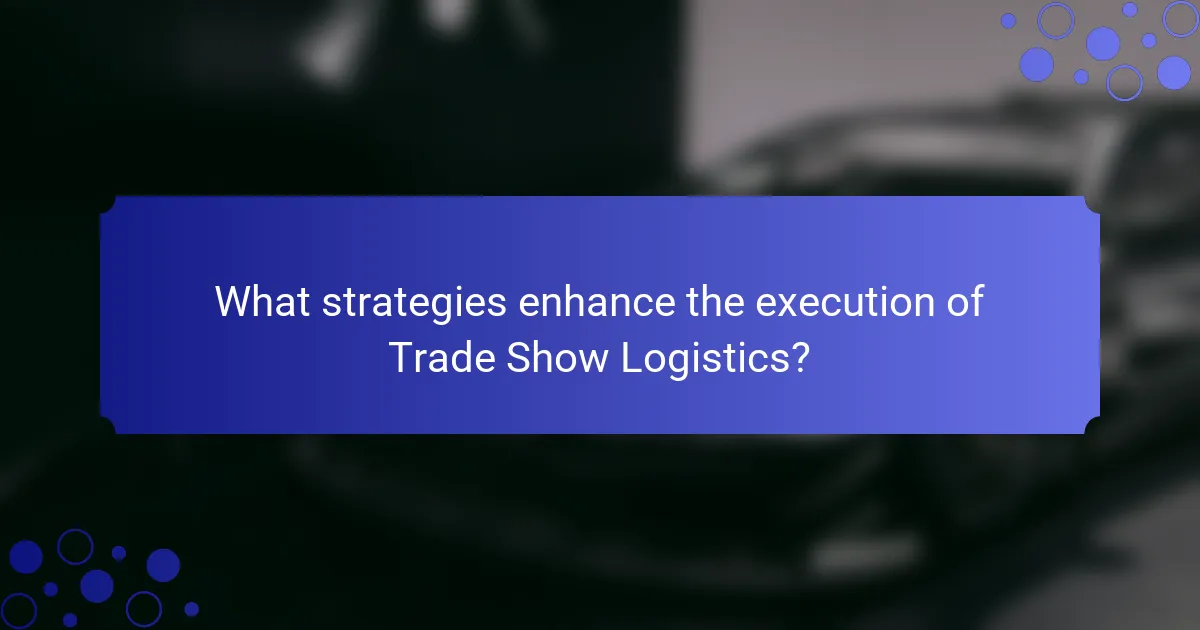
What strategies enhance the execution of Trade Show Logistics?
Effective strategies for enhancing the execution of trade show logistics include meticulous planning, clear communication, and technology utilization. Meticulous planning involves outlining timelines, resources, and responsibilities well in advance. Clear communication ensures all team members and stakeholders are aligned on objectives and tasks. Utilizing technology, such as event management software, streamlines processes and improves tracking.
According to a study by the Event Marketing Institute, 81% of marketers believe that technology enhances event execution. Additionally, having a dedicated logistics team can address issues promptly, reducing downtime during the event. Implementing a checklist system helps ensure that all logistical elements, such as transportation and booth setup, are completed on time. These strategies collectively contribute to a smoother execution of trade show logistics, maximizing impact and efficiency.
How can you ensure smooth execution during the event?
Plan detailed logistics before the event. Create a comprehensive timeline for setup and execution. Assign specific roles to team members to ensure accountability. Conduct a walkthrough of the venue to identify potential issues. Prepare contingency plans for unforeseen circumstances. Maintain clear communication among all team members during the event. Use technology to track progress and manage tasks efficiently. Regularly check equipment and supplies to ensure everything is functioning properly.
What are the common challenges faced during execution?
Common challenges faced during execution include logistical coordination, time management, and resource allocation. Logistical coordination involves ensuring all materials and equipment arrive on time. Delays can disrupt the setup process and affect overall event success. Time management is crucial as strict schedules must be adhered to for smooth execution. If tasks take longer than planned, it can lead to rushed preparations. Resource allocation challenges arise when there are insufficient staff or equipment to meet the demands of the event. This can result in operational inefficiencies and increased stress among team members. Additionally, communication breakdowns can occur, leading to misunderstandings and errors. Effective planning and contingency strategies are essential to mitigate these challenges.
How do you manage on-site logistics effectively?
To manage on-site logistics effectively, establish a detailed plan before the event. This plan should include timelines, resource allocation, and communication protocols. Assign specific roles to team members to ensure accountability. Use technology for real-time tracking of equipment and personnel. Conduct regular briefings to keep everyone informed of changes or updates. Implement a contingency plan for unexpected issues. According to a study by the Event Marketing Institute, 78% of event professionals believe that effective logistics planning is crucial for successful event execution. This shows the importance of thorough preparation and adaptability in on-site logistics management.
What metrics are important for evaluating execution success?
Key metrics for evaluating execution success in trade show logistics include attendance numbers, lead generation, and engagement levels. Attendance numbers indicate the event’s reach and interest. Lead generation measures the effectiveness of attracting potential clients. Engagement levels assess how well attendees interacted with the brand and its offerings. Other important metrics include booth traffic, conversion rates, and post-event surveys for feedback. These metrics provide a comprehensive view of the event’s performance and areas for improvement.
How do you measure attendee engagement during the event?
Attendee engagement during the event is measured through various metrics. Key metrics include session attendance, interaction levels, and feedback collection. Session attendance indicates how many participants attended specific sessions or activities. Interaction levels can be gauged by monitoring questions asked, networking activities, and participation in polls or surveys. Feedback collection involves using post-event surveys to assess attendee satisfaction and engagement. According to a study by Eventbrite, 85% of event organizers report using attendee feedback to improve future events. These measurements provide a comprehensive overview of attendee engagement.
What feedback mechanisms can be implemented during execution?
Feedback mechanisms that can be implemented during execution include real-time surveys, observation checklists, and communication tools. Real-time surveys allow participants to provide immediate feedback on their experience. Observation checklists enable staff to monitor key performance indicators as the event unfolds. Communication tools, such as instant messaging platforms, facilitate quick exchanges of information among team members. These mechanisms help identify issues promptly and adjust strategies accordingly. Research shows that immediate feedback can enhance overall event performance and attendee satisfaction.

How do you conduct post-event analysis in Trade Show Logistics?
Conducting post-event analysis in Trade Show Logistics involves several key steps. First, gather data on attendance numbers and visitor engagement. Analyze booth traffic and interactions to assess effectiveness. Collect feedback from team members and attendees about their experiences. Review logistical performance, including setup and teardown efficiency. Evaluate budget adherence and overall costs versus returns. Use surveys or interviews to capture qualitative insights. Compile this data into a comprehensive report. This report should highlight successes and areas for improvement, guiding future trade show strategies.
What are the key elements of post-event analysis?
The key elements of post-event analysis include data collection, performance evaluation, stakeholder feedback, and actionable insights. Data collection involves gathering quantitative and qualitative metrics from the event. Performance evaluation assesses the success against predefined goals, such as attendance numbers and lead generation. Stakeholder feedback is crucial for understanding participant experiences and identifying areas for improvement. Actionable insights are derived from the analysis to inform future events. These elements collectively help in refining strategies and enhancing future event outcomes.
How do you gather data for post-event analysis?
Gathering data for post-event analysis involves multiple methods. Surveys are commonly distributed to attendees immediately after the event. These surveys collect feedback on various aspects, including satisfaction and engagement. Attendance records provide quantitative data on participation rates. Social media analytics track online engagement and sentiment. Sales data from the event reveals the financial impact. Additionally, team debriefings capture qualitative insights from staff experiences. All these methods together create a comprehensive view of the event’s success and areas for improvement.
What tools can assist in analyzing trade show outcomes?
Tools that assist in analyzing trade show outcomes include analytics software, customer relationship management (CRM) systems, and survey platforms. Analytics software, like Google Analytics, tracks website traffic and engagement post-event. CRM systems, such as Salesforce, help manage and analyze leads generated during the trade show. Survey platforms, like SurveyMonkey, collect attendee feedback for insights on performance. These tools provide quantifiable data that helps evaluate success. For instance, using analytics software can show the increase in website visits after the event. This data-driven approach allows businesses to refine future strategies effectively.
What insights can be gained from post-event analysis?
Post-event analysis provides insights into the effectiveness and impact of the event. It identifies strengths and weaknesses in planning and execution. Attendee feedback highlights areas for improvement. Metrics such as attendance numbers and engagement levels reveal overall success. Financial analysis shows return on investment. Comparative analysis with past events indicates trends and patterns. This information helps inform future event strategies and decisions.
How can post-event analysis inform future trade shows?
Post-event analysis can significantly inform future trade shows by providing insights into attendee engagement and operational efficiency. This analysis involves evaluating metrics such as foot traffic, lead generation, and attendee feedback. By assessing these factors, organizers can identify successful elements and areas needing improvement. For instance, if a particular booth design attracted more visitors, future shows can replicate that design. Additionally, analyzing attendee feedback can highlight preferences and expectations, enabling tailored experiences. Historical data from past events shows that companies utilizing post-event analysis improve their ROI by up to 30%. Thus, leveraging these insights fosters better planning and execution for subsequent trade shows.
What are the best practices for reporting findings from analysis?
The best practices for reporting findings from analysis include clarity, conciseness, and visual aids. Clear communication ensures that the audience understands the key points. Conciseness helps maintain engagement by avoiding unnecessary information. Visual aids, such as charts and graphs, enhance comprehension by illustrating data effectively.
Additionally, structuring the report logically aids in guiding the reader through the findings. Using bullet points can highlight critical information succinctly. Providing context for the data helps the audience grasp its significance. Finally, summarizing the findings reinforces the main messages and supports retention.
What are the common pitfalls to avoid in Trade Show Logistics?
Common pitfalls to avoid in trade show logistics include poor planning, inadequate communication, and last-minute changes. Poor planning often leads to missed deadlines and insufficient resources. Inadequate communication can cause confusion among team members and vendors. Last-minute changes can disrupt schedules and increase costs. Additionally, neglecting to confirm vendor contracts can result in unexpected issues. Failing to account for transportation logistics can lead to delays in setup. Ignoring booth design and layout can affect attendee engagement. Lastly, not having a contingency plan can leave exhibitors unprepared for unforeseen circumstances.
How can you troubleshoot issues during setup and execution?
Identify the specific issue during setup and execution. Check equipment connections and functionality first. Ensure all required materials are on-site and accessible. Confirm that staff understands their roles and responsibilities. Review the event schedule for timing conflicts. Communicate with team members to gather feedback on problems. Utilize a checklist to verify that all tasks are completed. Maintain a flexible approach to adapt to unexpected challenges. Regularly assess progress to identify new issues early.
What strategies can help prevent logistical failures?
Implementing thorough planning and communication can help prevent logistical failures. Establish clear timelines and responsibilities for each team member. Utilize project management tools to track progress and identify potential issues early. Regularly conduct risk assessments to anticipate challenges and develop contingency plans. Ensure all stakeholders are informed and aligned on logistics strategies. Training staff on procedures can enhance preparedness and efficiency. Finally, gather feedback post-event to improve future logistics processes. These strategies are supported by industry best practices that emphasize proactive management and continuous improvement.
Trade show logistics encompass the planning, execution, and analysis of all elements involved in participating in trade shows, including transportation, booth setup, and material handling. Effective logistics significantly influence event success by ensuring timely delivery and proper setup, which enhances attendee experience and engagement. Key components include detailed planning, on-site management, and post-event analysis, which evaluates performance metrics such as attendance and lead generation. Best practices for setup and execution focus on clear communication, resource allocation, and the use of technology to streamline processes and address challenges efficiently.
